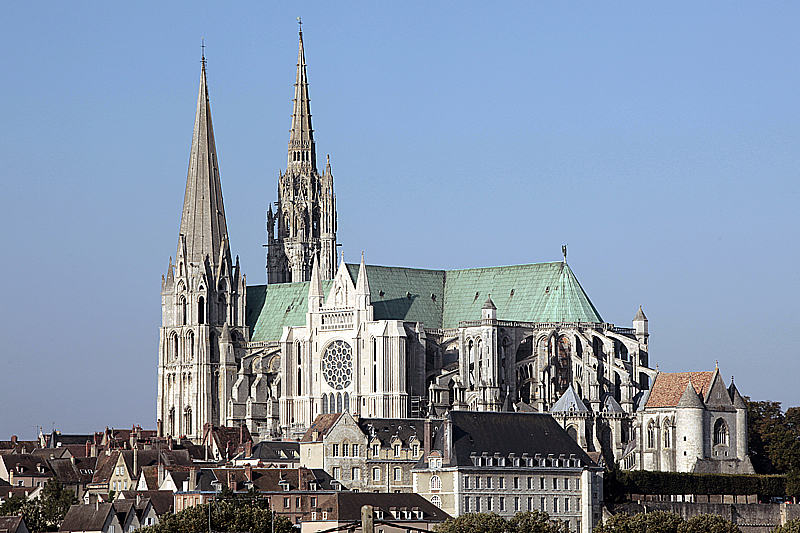Man of the Day: The Man Who Saved the Past
“Colonel,” said the aide, “your commands are clear. We have to shell the cathedral.”
The scene was fifty miles away from Paris, the great capital of France. The countryside far and near showed all the signs of war: burnt fields, buildings falling apart, great craters in the earth where the bombs hit, scrawny cattle wandering here and there. In the distance, towering high above the land, stood the great cathedral of Chartres. Some people say that it is the most beautiful cathedral in the world. I say more: I think it is the most beautiful building in the world, of any kind.

Behind the colonel and his aide were hundreds of young Frenchmen, armed with rifles. They were part of the French resistance against the German Nazis, who had invaded France five years before. Now the Americans, the British, their allies, and the most loyal and courageous of French youths were taking the nation back, mile by mile, shedding their blood to do it. The Germans were in control of the town of Chartres. The colonel knew it. So did the Frenchmen. And the orders were clear. The colonel’s commanding officers believed that the Nazis were occupying the cathedral. They had to be destroyed, and that meant that the cathedral had to be destroyed.
In the picture you may see one of the “rose” windows of Chartres, in stained glass, devoted to the Virgin Mary, the patroness of the cathedral. We still do not know for certain how the glaziers managed to color the glass with that deep and rich blue. The windows are beyond price. Fortunately, the French had carefully removed all of the windows from their places before the Germans came pouring in. The windows at least were safe, for the time being. But the cathedral! What good would it have done to save the windows, if the cathedral where the windows hung were to be reduced to rubble?
The colonel, Welborn Barton Griffith, Jr., was not a young man. He had seen a lot of action in the war. He knew that information in wartime could be mistaken. He understood that the Germans held the town, and that he was supposed to drive them out. But he was not yet persuaded that he had to destroy Chartres Cathedral to do that.
“Son,” he said to his aide, “let’s take a ride over to the front.” For there were American troops stationed near the town, also waiting the order to strike. The other Americans told him where they thought the Germans were hiding – and waiting.
“We’ll have to leave the jeep here,” said Colonel Griffith. “Let’s go, boy,” he said, and they picked their way through abandoned neighborhoods, taking care not to be noticed, and avoiding where the nests of Germans were supposed to be. Finally they were in the shadow of the cathedral.
“What do we do now, sir?” the aide asked. “We can’t get inside, and even if we could, we’d be sitting ducks if the Nazis are in there.”
“The bell tower will do it,” said Colonel Griffith. For you must know that there are stairs inside those great towers, for men to climb when they need to clean the bells.
So the colonel and his aide climbed the tower, and from there they looked into the cathedral, which of course no longer had any windows – those were being kept safe, in hiding.
All was still, except for the cooing of the pigeons in the nooks of the tower.
“I don’t see anything,” said Colonel Griffith. “How about it, son?”
“I don’t think there’s anyone in there at all,” said the aide.
“Let’s go,” said the Colonel.
When they returned to the American lines, Colonel Griffith told them that they would not be shelling the cathedral. He rescinded the order, on his own responsibility. The cathedral was to remain untouched.
That was August 16, 1944. The battle lasted three days, and the Germans were driven out. But after he had saved the cathedral, Colonel Griffith and his driver went a couple of miles north, to a village called Leves. There he spotted a nest of German machine gunners. So he went back to the American troops, and led a charge of tanks against the Germans. Colonel Griffith was a big man and could not fit into the tank he had climbed on top of, but he knew it was his duty to lead, and so he did. He died that same day, the day he saved a masterpiece of human art, built by hundreds of human hands to the glory of God.
If you go to the village of Leves, you may see a memorial that the grateful French people have raised to the honor of Colonel Griffith. It reads, with honest simplicity:
Ici Fut Tue
Le 16 Aout 1944
Le Colonel Americain
Welborn B. Griffith
Which means:
Here was Slain
On August 16, 1944
The American Colonel
Welborn B. Griffith
And every August 16, they hold a ceremony, to show their gratitude to the man who saved Chartres Cathedral.
View or print this issue as a pdf.


Wow! Thank you Jesus! We need stories of courage and common sense in these times of absurdity.
A story of true courage and valor, beautifully told. Thank you. Crying to think of what we lose when any of these glorious structures is destroyed.